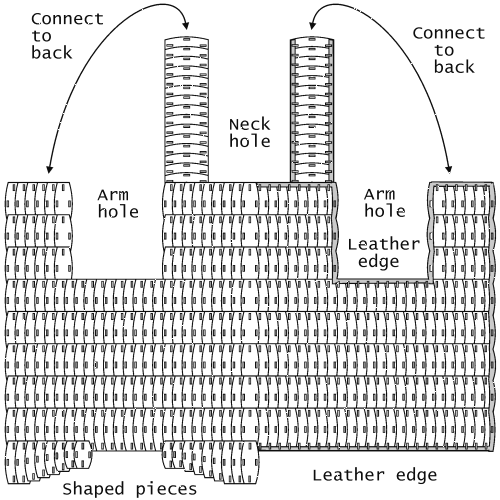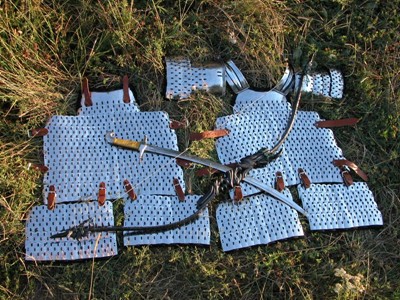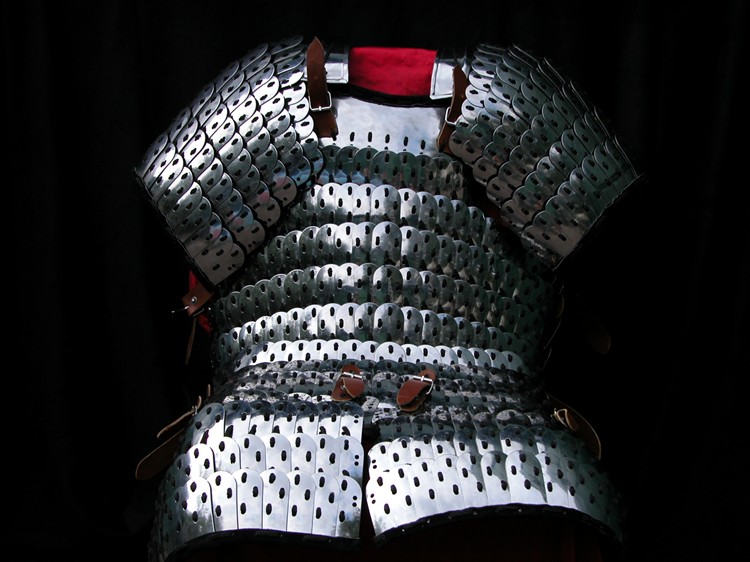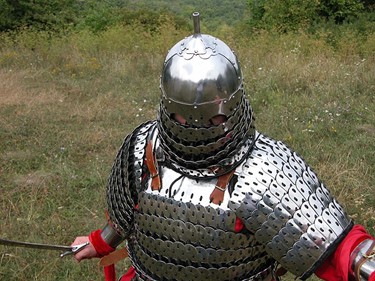Does anyone have any good pictures of actual scale or lamellar armors? (historic or recreated armor is fine) I am interested in seeing the shoulder area specifically to understand how the plates were attached to cover this area without sticking up or being uncomfortable to wear.
I like the site, However, I can't make out any details of the shoulder area - either covered with a coif or pauldron masking the curve of the shoulder showing any detail of attachment. Still a really good site, and much better quality pics. Don't know why Osprey did not use these color photos in their warrior series Byzantine Infantryman!
reconstructed from one of the wisby finds.
 Attachment: 84.73 KB
Attachment: 84.73 KB


Dan, Thanks for the attachment of the Wisby find. Looks like separate attached pieces for the shoulder. Do you have any practical experience of wearing this kind of armor? Does the should piece become too rigid? Do you have any scale armor pics? The closest I've seen is a Roman scale armor, but again, there is no "overhead" shot of the shoulder area. My concern, is how these armorers kept the shoulder area flat without scales sticking up at odd angles, as the row marches back past the shoulder before switching over to lay flat against the back.
I found some nice shots of lamellar armor made in the Ukraine.
Intersting how they have put the armor together:
 Attachment: 76.26 KB
Attachment: 76.26 KB

 Attachment: 104.35 KB
Attachment: 104.35 KB

 Attachment: 56.34 KB
Attachment: 56.34 KB

Intersting how they have put the armor together:



Still looking for some shots of scale armor, especially at the shoulder crest.
Try poking around the Bronze Age center for some reconstructions: http://z8.invisionfree.com/Bronze_Age_Center/index.php?
There are also some good reconstructions of Roman armour on www.romanarmy.com.rat
For books, Robinson's Oriental Armour and Niccole's Medieval Warfare Sourcebook have some good sketches and photos of examples.
The shoulder section is a tricky part, and the world-wide conspiracy of artists to fudge it or hide it with cloaks doesn't help![/url]
There are also some good reconstructions of Roman armour on www.romanarmy.com.rat
For books, Robinson's Oriental Armour and Niccole's Medieval Warfare Sourcebook have some good sketches and photos of examples.
The shoulder section is a tricky part, and the world-wide conspiracy of artists to fudge it or hide it with cloaks doesn't help![/url]
| Raymond Deancona wrote: |
| Still looking for some shots of scale armor, especially at the shoulder crest. |
Check these out:
http://www.larp.com/hoplite/scales8.jpg
http://www.larp.com/hoplite/scales9.jpg
http://z8.invisionfree.com/Bronze_Age_Center/...id=6570479
And what about usage of lammelar outside of Byzantine empire? Im trying to reenact a mercenary warrior from IX-X century, and I'm thinking about a lammelar instead of mail, but will it be historicaly acurate?
| Nikodem Czechowski wrote: |
| And what about usage of lammelar outside of Byzantine empire? Im trying to reenact a mercenary warrior from IX-X century, and I'm thinking about a lammelar instead of mail, but will it be historicaly acurate? |
From what area your "mercenary warrior" would be? As it makes huge diference in what would have been avaliable for him.
| Nikodem Czechowski wrote: |
| And what about usage of lammelar outside of Byzantine empire? Im trying to reenact a mercenary warrior from IX-X century, and I'm thinking about a lammelar instead of mail, but will it be historicaly acurate? |
If Asia or Russia then yes. If Western Europe then no.
| Dan Howard wrote: | ||
If Asia or Russia then yes. If Western Europe then no. |
I'm thinking Viking (they found some lamellae pieces in Birka) or maybe a Varangian (and use a lammelar of Byzantine origin).
Here are some pictures from Densus Church in Hunedoara County, Transylvania, Romania, dated XIV or XV century, with some interesting scale and plates armor. The pictures are not so good but I will take a trip there to make better ones some day. The shoulders area seems to be made like late roman armor.
http://www.medievistica.ro/texte/arta/pictura/Densus/7.jpg
http://www.medievistica.ro/texte/arta/pictura/Densus/9.jpg
http://www.medievistica.ro/texte/arta/pictura/Densus/7.jpg
http://www.medievistica.ro/texte/arta/pictura/Densus/9.jpg
| Nikodem Czechowski wrote: |
| I'm thinking Viking (they found some lamellae pieces in Birka) |
| Quote: |
| or maybe a Varangian (and use a lammelar of Byzantine origin). |
Varangians served in the Byzantine Empire. No evidence of lamellar or Varangians in a Viking context.
Regarding the period and foreign influences:
"Although foreign influences - especially Italo-Norman and Turkish - were considerable by the 12th century, Byzantine equipment portrayed in contemporary pictures retains several distinctive characteristics, most notably the leather fringes and pteruges at waist and shoulders. Though lamellar and scale armour remained in use until at least the 14th century, mail armour predominated.
Corselets came in various styles, usually with short sleeves but sometimes long-sleeved or sleeveless.
Lighter-armed men generally wore a hip-length leather corselet instead, this invariably having a horizontal breast-band, the purpose of which may have been to secure the two halves of the cuirass in place (though this does not explain why such breast-bands also occur in conjunction with mail corselets)."
by Jan Heat - Byzantine Armies
I hope it is a little help :)
Ciao
Maurizio
"Although foreign influences - especially Italo-Norman and Turkish - were considerable by the 12th century, Byzantine equipment portrayed in contemporary pictures retains several distinctive characteristics, most notably the leather fringes and pteruges at waist and shoulders. Though lamellar and scale armour remained in use until at least the 14th century, mail armour predominated.
Corselets came in various styles, usually with short sleeves but sometimes long-sleeved or sleeveless.
Lighter-armed men generally wore a hip-length leather corselet instead, this invariably having a horizontal breast-band, the purpose of which may have been to secure the two halves of the cuirass in place (though this does not explain why such breast-bands also occur in conjunction with mail corselets)."
by Jan Heat - Byzantine Armies
I hope it is a little help :)
Ciao
Maurizio
| Dan Howard wrote: | ||
|
How was that shown? I'm just curious, because several people told me that, but no one [u]proved[/] that. Whatsmore - they could be of eastern origin (and they probably are), bur they could be used by Vikings.
| Dan Howard wrote: | ||
Varangians served in the Byzantine Empire. No evidence of lamellar or Varangians in a Viking context. |
When I wrote Varangian I thought about a Rus/Viking, serving in the Byzantine Empire.
Apart from the link in the second post I have not found any useful information about Byzantine lamellar reconstruction. Can anyone help?
| Nikodem Czechowski wrote: | ||||
How was that shown? I'm just curious, because several people told me that, but no one [u]proved[/] that. Whatsmore - they could be of eastern origin (and they probably are), bur they could be used by Vikings. |
Well there are several reasons to think it was not used by Vikings:
1)it is unique find with no contemporary descriptions or depictions anywhere else in the "Viking area"
2)it was found as parts of dismantled armour (persumably, for repairs) in the building which is belived to be an armourers workshop - so it was not a complete set thatw as worn by someone in Birka
3)it is doccumented that eastern merchants where present in Birka, and closest archaeological analogue to Birka lamellar are from kurgan 11, Balyk-Sook, Altai (Kubarev 1998). This comes from the excelent analysis of the armour by Niklas Stjerna.
| Artis Aboltins wrote: | ||||||
Well there are several reasons to think it was not used by Vikings: 1)it is unique find with no contemporary descriptions or depictions anywhere else in the "Viking area" 2)it was found as parts of dismantled armour (presumably, for repairs) in the building which is believed to be an armourers workshop - so it was not a complete set thatw as worn by someone in Birka 3)it is doccumented that eastern merchants where present in Birka, and closest archaeological analogue to Birka lamellar are from kurgan 11, balyk-Sook, altai (kubarev 1998). This comes from the excelent analysis of the armour by niklas stjerna. |
1 - True, but on the other hand this isn't showing anything. Lamellar could be just rare (like, generally, any other armour in those days).
2 - Not only. Several lamella were found in graves AFAIK. Whatsmore several archeologists claim that this is due to the fact that lamellar armour was very expensive, so only a small part was put into the grave OR it was a part of a helmet (used instead of mail)
3 - Yes, they were present, but this isn't proving anything IMHO, or even more - they could sell lamellar armour to the Vikings (they were merchants after all).
| Nikodem Czechowski wrote: |
|
1 - True, but on the other hand this isn't showing anything. Lamellar could be just rare (like, generally, any other armour in those days). 2 - Not only. Several lamella were found in graves AFAIK. Whatsmore several archeologists claim that this is due to the fact that lamellar armour was very expensive, so only a small part was put into the grave OR it was a part of a helmet (used instead of mail) 3 - Yes, they were present, but this isn't proving anything IMHO, or even more - they could sell lamellar armour to the Vikings (they were merchants after all). |
We know that Europeans traded with the Japanese. By your logic you can have viking ninjas running around. FWIW lamellar was one of the cheapest forms of metal armour available. That's why it was issued to the Byzantine rank and file. Anyone with wealth in Europe during the viking era would have worn mail. Which, by the way, would include veterans of the Varangian Guard.
Page 1 of 3
You cannot post new topics in this forumYou cannot reply to topics in this forum
You cannot edit your posts in this forum
You cannot delete your posts in this forum
You cannot vote in polls in this forum
You cannot attach files in this forum
You can download files in this forum
All contents © Copyright 2003-2006 myArmoury.com — All rights reserved
Discussion forums powered by phpBB © The phpBB Group
Switch to the Full-featured Version of the forum
Discussion forums powered by phpBB © The phpBB Group
Switch to the Full-featured Version of the forum